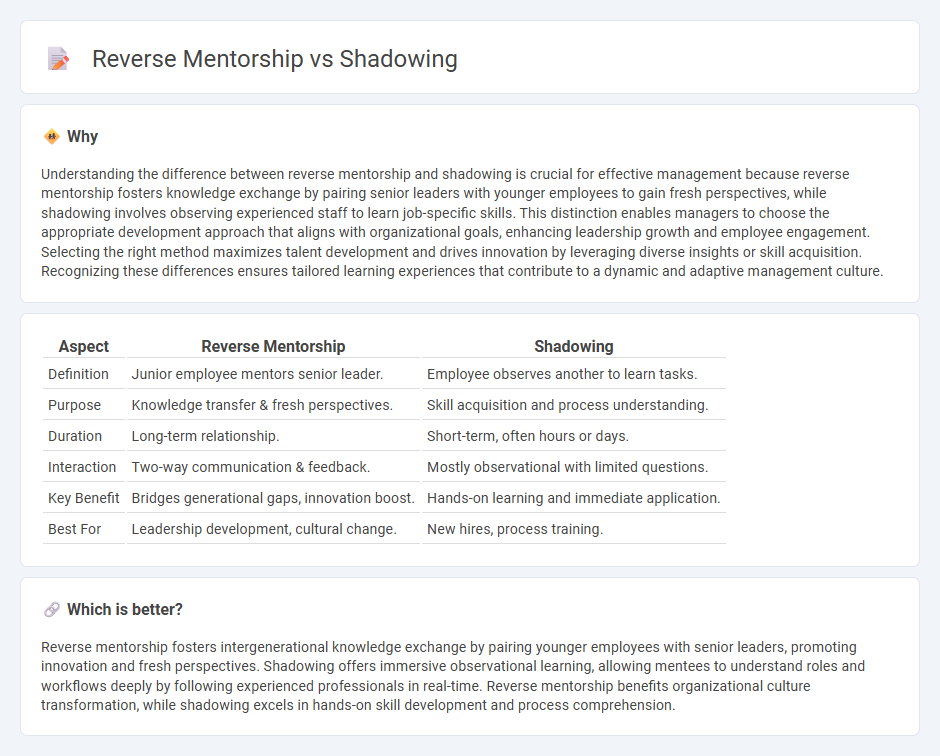
Reverse mentorship flips traditional roles by pairing younger employees with senior leaders to share fresh perspectives and digital skills, enhancing leadership adaptability and innovation. Shadowing allows individuals to observe experienced professionals in real-time work settings, gaining practical insights and firsthand knowledge of job functions. Discover how these approaches can transform organizational learning and career development.
Why it is important
Understanding the difference between reverse mentorship and shadowing is crucial for effective management because reverse mentorship fosters knowledge exchange by pairing senior leaders with younger employees to gain fresh perspectives, while shadowing involves observing experienced staff to learn job-specific skills. This distinction enables managers to choose the appropriate development approach that aligns with organizational goals, enhancing leadership growth and employee engagement. Selecting the right method maximizes talent development and drives innovation by leveraging diverse insights or skill acquisition. Recognizing these differences ensures tailored learning experiences that contribute to a dynamic and adaptive management culture.
Comparison Table
| Aspect | Reverse Mentorship | Shadowing |
|---|---|---|
| Definition | Junior employee mentors senior leader. | Employee observes another to learn tasks. |
| Purpose | Knowledge transfer & fresh perspectives. | Skill acquisition and process understanding. |
| Duration | Long-term relationship. | Short-term, often hours or days. |
| Interaction | Two-way communication & feedback. | Mostly observational with limited questions. |
| Key Benefit | Bridges generational gaps, innovation boost. | Hands-on learning and immediate application. |
| Best For | Leadership development, cultural change. | New hires, process training. |
Which is better?
Reverse mentorship fosters intergenerational knowledge exchange by pairing younger employees with senior leaders, promoting innovation and fresh perspectives. Shadowing offers immersive observational learning, allowing mentees to understand roles and workflows deeply by following experienced professionals in real-time. Reverse mentorship benefits organizational culture transformation, while shadowing excels in hands-on skill development and process comprehension.
Connection
Reverse mentorship and shadowing are connected through their focus on experiential learning and cross-generational knowledge transfer within management. Reverse mentorship allows junior employees to share insights with senior leaders, while shadowing provides real-time observation of managerial practices, fostering mutual understanding and skill development. Together, these strategies enhance leadership effectiveness and organizational agility by bridging experience gaps and promoting continuous learning.
Key Terms
Learning Transfer
Shadowing enhances learning transfer by allowing mentees to observe experienced professionals in real-time, gaining practical insights and tacit knowledge. Reverse mentorship fosters bidirectional learning, where junior employees share fresh perspectives and digital skills with senior colleagues, enriching organizational knowledge. Discover how combining these methods can maximize effective learning transfer in your workplace.
Hierarchical Dynamics
Shadowing involves a junior employee closely observing a senior colleague to gain insights into leadership and decision-making processes, reinforcing traditional hierarchical dynamics. Reverse mentorship flips this model, empowering junior staff to share fresh perspectives and technological expertise with senior leaders, promoting more reciprocal and less rigid power structures. Explore the implications of these approaches on organizational culture and employee development to better understand their impact.
Cross-generational Knowledge
Shadowing allows younger employees to observe experienced professionals, fostering tacit knowledge transfer across generations. Reverse mentorship empowers younger workers to share digital skills and fresh perspectives with senior leaders, promoting mutual learning. Explore how combining both approaches enhances cross-generational knowledge exchange.
Source and External Links
Speech Shadowing - A psycholinguistic technique where participants repeat speech at a delay to study speech processing and production.
Job Shadowing Guide - A career development tool that allows individuals to learn about a job by following a professional through their daily tasks.
Shadowing Technique - A language learning method that involves imitating a native speaker's speech to improve speaking skills.
 dowidth.com
dowidth.com